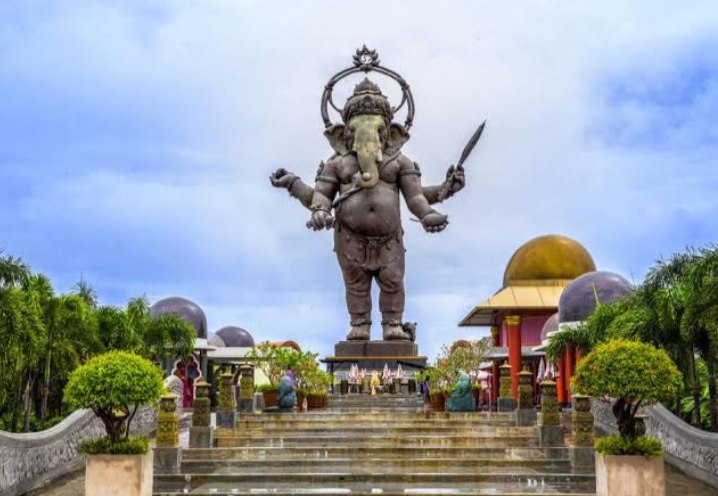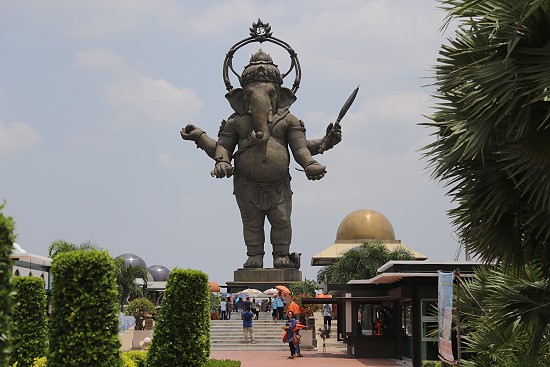“Did You Know? The World’s Tallest Lord Ganesha Statue Is Outside India”

“Did You Know? The World’s Tallest Lord Ganesha Statue Is Outside India”
Lord Ganesha: the beloved elephant-headed deity, son of Lord Shiva and Goddess Parvati — is revered across Hinduism as the remover of obstacles, the god of intellect, wisdom, and new beginnings. He is a central figure in rituals from the moment a journey starts, a home is built, or a book is opened.
Naturally, India — the cradle of Hinduism — is dotted with thousands of temples, shrines, and towering idols dedicated to Ganesha. But here’s a surprising twist: the world’s tallest standing statue of Lord Ganesha isn’t in India. Instead, it rises magnificently in the heart of Thailand.
The Tallest Lord Ganesha Statue in the World
Located in Khlong Khuean Ganesh International Park in Chachoengsao province, Thailand, this colossal bronze statue stands at an awe-inspiring 39 metres tall (approximately 128 feet). Completed in 2012 after four years of meticulous work, it holds the title of the tallest standing Ganesha statue on the planet.
The structure was assembled from 854 intricately crafted bronze pieces and occupies a sprawling 40,000 square metres of land, with the serene Bang Pakong River flowing nearby. The statue’s sheer size and spiritual significance have turned it into a major destination for pilgrims, spiritual seekers, and tourists alike.
Deep Symbolism Behind the Statue
Designed by Thai artist Pitak Chaleumlao, this Ganesha figure carries profound meaning for the Thai people. Unlike the more common seated Ganesha, this statue shows him in a forward-stepping posture, symbolising progress and momentum.
Each of his four hands holds a fruit — sugarcane, jackfruit, banana, and mango — representing abundance, fertility, and blessings. The lotus-shaped crown atop his head stands for wisdom, and the presence of the sacred “Om” symbol at the pinnacle underlines Ganesha’s divine protective energy. This is not just a statue; it’s a physical embodiment of Thai hopes for prosperity and spiritual growth.
Ganesha’s influence in Thailand is centuries old, tracing back to the era when Brahmanism (an early form of Hinduism) spread across Southeast Asia. Over time, Ganesha became deeply integrated into Thai culture and is now venerated as “Phra Phikanet”, the god of success and intellect.
His image appears not only in temples but in schools, universities, offices, and homes. Many Thai people, especially artists, entrepreneurs, and students, pray to Ganesha for blessings in their creative and professional pursuits. Annual festivals and public rituals further reflect how seamlessly Hindu deities like Ganesha have blended into Thailand’s Buddhist-majority culture.
Khlong Khuean Ganesh International Park: A Spiritual Hub
The grand Ganesha statue forms the centrepiece of Khlong Khuean Ganesh International Park, designed as a spiritual, cultural, and educational hub. The park isn’t just about worship; it serves the broader purpose of preserving local heritage, supporting community development, and boosting tourism in the Chachoengsao region.
Visitors to the park can immerse themselves in rituals, enjoy the peaceful environment, and learn about Thai spiritual beliefs. It’s a place where culture and faith intersect beautifully.

Other Notable Ganesha Statues in Thailand
Thailand is home to many revered Ganesha statues besides the one in Chachoengsao. Some other popular sites include:
Ganesha Shrine, Huai Khwang (Bangkok): A highly frequented shrine where locals seek success in studies and careers.
Phra Phikanet, Central World (Bangkok): A modern city-centre shrine that attracts daily worshippers.
Seated Ganesha Statue, Nakhon Nayok: Another large, peaceful Ganesha idol located just outside the capital.
Planning Your Visit: Important Details
Location: 62 Moo 4, Bangtalad, Khlong Khuean, Chachoengsao, Thailand
Timings: 8:00 AM to 5:00 PM daily
Entry Fee: 100 Thai Baht (approx ₹240) for foreigners; free for Thai nationals
Best Time to Visit
Thailand’s tropical climate makes some months more suitable than others for a comfortable visit:
November to February: Cool, dry, and ideal for sightseeing.
March to May: Hot and humid — carry sun protection if visiting.
June to October: Rainy season; travel may be unpredictable due to heavy showers.
Things to Do Near the Ganesha Statue
If you’re heading to Chachoengsao, consider making it a full-day cultural excursion. Nearby attractions include:
Wat Sothon Wararam Worawihan: A grand and revered Buddhist temple with striking architecture.
Ban Mai Riverside Market: A vibrant market known for traditional Thai street food, handmade crafts, and souvenirs.
Bang Pakong River: Take a peaceful boat ride or simply enjoy the scenic riverside walkways.
How to Get There from Bangkok
Chachoengsao is located about 80 km east of Bangkok, making it perfect for a day trip.
By Train: Trains from Hua Lamphong Station take 1.5–2 hours to Chachoengsao Junction, followed by a taxi or tuk-tuk.
By Bus: Regular buses from Ekkamai or Mo Chit Bus Terminals in Bangkok.
By Car/Taxi: The drive takes around 1.5 hours, depending on traffic.
The towering Lord Ganesha statue in Thailand is more than just a record-breaking monument. It’s a symbol of devotion that transcends national boundaries, a fusion of Indian spiritual heritage and Thai cultural pride. For those seeking a spiritual journey, artistic admiration, or a deeper understanding of Southeast Asia’s sacred traditions, Khlong Khuean Ganesh International Park offers an unforgettable experience.












